Relax, email marketing isn’t dead.
In fact, it’s one of the most effective ways to build an authentic connection with your audience and turn them into recurring customers.
People who say email marketing is dead are mostly old-school marketers who never tried anything besides the old “email blast” tactic of sending the same emails to everyone regardless of their interests.
This “email blast” tactic is, in fact, dead, as things have changed a lot since the early days of email marketing.
In this ultimate email marketing guide for beginners, we’ll take a look at everything about email marketing, such as how to do it yourself, growing your list, segmenting your list, improving deliverability, and more.
Contents
- What is email marketing?
- Why is email marketing important?
- How to do email marketing yourself
- How to grow your email list
- How to choose an email marketing software
- Segmenting your email list
- How to improve email deliverability
- How to increase email open rate
- Automated email marketing campaigns
- Email regulations
- Measuring email campaigns performance
- How to calculate email marketing ROI
- Common email marketing mistakes
- Final thoughts: Email marketing guide
Disclosure: You should always assume that pretty much every link on this site is an affiliate link, and if you click it and buy something you like, I’ll earn some money to help me buy a DeLorean, build a time machine, and travel back to the 90s so I can watch Hey Arnold! and eat Dunkaroos again.
What Is Email Marketing?
Email marketing is a digital marketing strategy where you send emails to subscribers and customers to establish authority, build trust, and make sales.
An effective email marketing strategy converts subscribers into customers and first-time buyers into recurring customers.
And no, email marketing isn’t just about sending random emails to subscribers. These emails must be highly optimized and targeted to help build brand awareness and maximize sales.
Don’t worry, though. We’ll talk more about how to create an effective email marketing strategy later in this guide.
Why Is Email Marketing Important?
I know, I know.
There are a ton of social media platforms out there that it might seem like email marketing is useless now.
But that isn’t the case.
In fact, email marketing still remains the most effective way to turn your subscribers into super-fans and loyal customers.
The issue with social media is that people on it aren’t looking to buy things, they’re there to stalk other accounts and pass the time.
Whenever you post something on social media, you have to wait for your followers to scroll far enough down their feed to see it. And after a few hours, it will be almost impossible to find.
When it comes to email, your content is delivered directly to their inbox, making it a more personal way to connect with your customers.
Here are three reasons why email marketing is so important for businesses looking to boost sales:
a) Most Used Method of Communication
I can spend several days without checking my social media accounts. In fact, I don’t even have Facebook or Instagram installed on my phone. But I check my email every single day.
And I’m definitely not the only one. According to OptinMonster, at least 99% of email users check their emails every day.
With 3.9 billion daily users, email is the most used channel of communication. And this number is expected to increase to 4.3 billion by 2023, according to Statista.
There are also over 5.6 billion active email accounts worldwide.
b) Highest Conversion Rate
Getting people to buy your products or services is the whole point of marketing.
The return on investment (ROI) for email marketing can be as high as 4400%, according to Campaign Monitor. That’s $44 for every $1 you spend on an email marketing campaign.
Marketers around the world estimated that email generated a median ROI of 124% in 2017, which is by far the highest among other channels like social media, direct mail, paid search, and online display, according to Statista.
The second highest one was social media at only 30%.
Lastly, another study done by Statista showed that according to B2B marketing professionals, email to first-party lists is one of the best ways to build trust with your audience and create high-quality leads.
Don’t worry, we’ll talk more about calculating your email marketing ROI later in this guide for beginners.
Return on investment (ROI) measures the gain or loss generated by an investment in relation to its initial cost. This allows you to see how well your email marketing efforts are performing so you can make changes if necessary. The higher the ROI, the better.
c) You Own Your List
This is another reason why email marketing is often better than social media. With social media, you’re bound to their rules and algorithm changes.
Let’s say you spend years building your Instagram following and one day the platform shuts down or decides to ban your account.
Poof!
There goes all your hard work and followers.
With email, you own your list of subscribers. You can download that list and have access to your subscribers as long as they don’t unsubscribe.
How to Do Email Marketing Yourself
If you’re just starting a blog or small business, chances are you don’t have the budget to have someone manage your email marketing campaigns.
Don’t worry. Handling your email marketing campaigns isn’t that complicated.
In this section, we’ll take a quick look at how the process works.
- Develop a marketing strategy – taking some time to think things through and develop a business strategy is a valuable step that many business owners miss. Taking time to develop a marketing strategy will save you time, money, and frustration.
- Create an opt-in to capture email subscribers – nowadays, people don’t just join email lists. To get subscribers, you need to offer them some value in exchange for their email addresses. This is what’s often called a “freebie” or “opt-in incentive.”
- Choose an email service provider (ESP) – your ESP will have a great impact on your deliverability, so make sure that you choose a good one. An ESP will allow you to send broadcast and automated email sequences to your subscribers.
- Build an email sequence – this is a series of emails sent to your new subscribers to build trust, establish authority, and ultimately make a sale.
How to Grow Your Email List
One of the biggest challenges business owners face is growing their email lists. When it comes to getting subscribers, there are several moving parts, such as creating enticing lead magnets, clear opt-ins, and driving traffic to those offers.
In this section of the email marketing guide for beginners, we’ll go over how to do all of these things and grow your email list.
a) Lead Magnets
It used to be that simply telling visitors to subscribe to your newsletter was enough to get them to do it.
Unfortunately, this technique doesn’t work very well anymore. People are constantly receiving emails, whether it’d be business emails, subscriptions, or spam. Last thing they want is to join another email list and receive more email.
A great way of getting people to sign up for your list is by offering them something valuable in exchange for their email address.
This is often referred to as lead magnet or freebie.
For example, if you had a nutrition business, you could offer people a free 5-day meal plan in exchange for their email address.
You could also offer things like:
- Free mini-courses
- Checklists
- Cheat sheets
- Printables
- Coupons
- Templates
- Webinars
- Free trials
- Free consultations
How to Make a Lead Magnet That Converts
Needless to say, giving random stuff isn’t going to convert well either. A lead magnet must be something that your visitors find valuable.
Here are a few guidelines to help you create a good lead magnet:
- Solve a problem – the biggest thing about your lead magnet is that it has to solve a problem your audience is having. Are they trying to lose weight? If so, you could offer them a 5-day meal plan or a 3-day workout plan.
- Make it actionable – create something they can start implementing right away.
- Keep it short – don’t create a long eBook or a 30-day email course. While you still want to create something useful, you don’t want to give everything away. If they want to learn more, they can purchase your actual product.
- Offer a quick win – we live in an era where people want things right away. A good lead magnet will offer your subscribers a quick win so they can see that you know what you’re talking about and your product works.
- Make it relevant – to increase conversion rates, your lead magnet should be highly relevant to what your audience is looking for. For example, if you wrote a blog post about the best foods to eat to lose weight and included a free 3-day workout lead magnet, you might not get as many subscribers as you would had you offered them a free 5-day meal plan lead magnet instead. Even though working out is related to weight loss, your visitors are most interested in what to eat, not exercise. On the other hand, if you wrote an article on how to build muscle, your visitors would be more interested in the workout lead magnet than the meal plan one.
b) Opt-In Forms
An opt-in form is a form of consent given by your visitors, acknowledging interest in a product or service and allowing you to contact them with more information.
This is mostly used in email marketing for permission to send newsletters, product deals, and any other type of commercial email.

Opt-ins forms are typically shown to your website visitors in the form of pop-ups, inline forms, landing pages, or widgets inside your blog posts or product pages.
Opt-Ins are Required by Law
With the crapload of spam and scam emails people receive every day, it is no surprise that the CAN-SPAM Act of 2003 requires businesses to represent their identity and intentions when sending commercial emails.
Don’t worry. We’ll talk more about email regulations later in this email marketing guide for beginners.
How to Create an Opt-In Form That Converts
When it comes to creating an opt-in form that converts, it’s better to keep things simple and straight to the point.
Here are some guidelines to help you create a high-converting opt-in form:
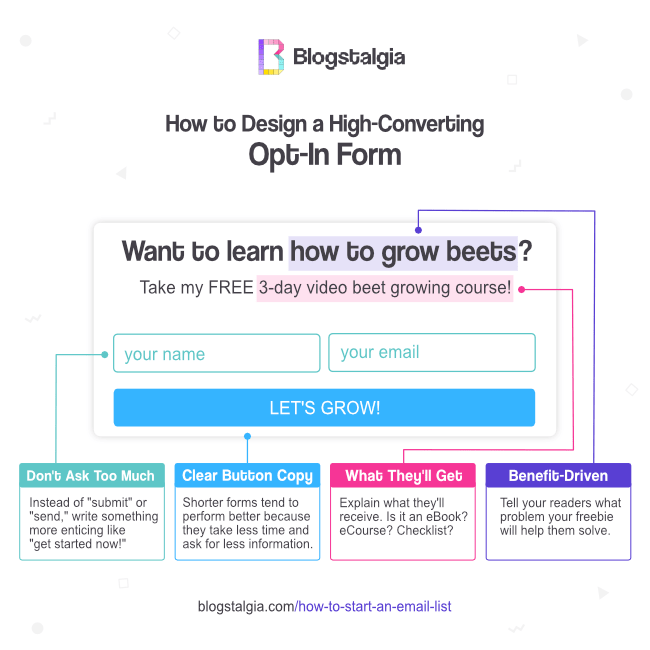
- Clear headline – just by reading the headline, your visitors should have a clear idea of how your lead magnet is going to help them.
- Short description – you can add a short description to add more info about the lead magnet.
- Delivery format – tell them in what format their lead magnet will be delivered. Is it a PDF checklist? an eBook? email course?
- Engaging button copy – don’t just write “submit form”. Write something engaging that makes people want to sign up. For example, you could write something like “Get Your Free eBook!” or “Enroll in the Course!”
- Don’t ask for too much info – only ask for their first name and email (or just their email). Shorter forms tend to perform better.
- Use contrasting colors – make sure that your opt-in form catches your visitors’ eyes and the subscribe button contrasts with the background color.
- Add visuals – you can also add some eye-catching visuals. For example, if you’re giving out a free eBook, you could add a mockup of it. You can use a tool like Canva to create cool visuals.
Opt-In Form Placement
As you can imagine, there are many different places you can add your opt-in form and drive conversions.
Here are the most common ones:
- Within your blog posts – this is my favorite place to add opt-in forms. Adding them within your blog posts is not as intrusive as using annoying pop-ups.
- About page – great place to add an opt-in form that many people forget about. People are already interested in your company and are looking to learn more about it. Ask them to join your list while exploring your site.
- Pop-ups – I hate them, but they convert very well. If you want to use them, go for it. Just keep in mind that intrusive pop-ups can affect your Google rankings.
- Exit-Intent Pop-up – an exit-intent pop-up will show up whenever a visitor is about to leave your site. I like this as an alternative to regular pop-ups because at this point, users have already read what they wanted to and are going to leave your site anyway.
- Scroll mat – another intrusive but effective way of collecting subscribers. A scroll mat turns your page into a full screen opt-in form that’s displayed as soon as a visitor lands on your site. This pushes the content below the fold so visitors can’t miss it.
- Header – I like opt-in headers more than scroll mats since they don’t typically take the whole screen and the user can get a glimpse of the content.
- After content – placing one at the end of your blog post is a great way of converting highly engaged visitors. I mean, if someone read your whole article, they’re definitely interested in what you have to say.
- Footer – good if you want to have a way for visitors to join your list on every page on your site.
- Sidebar widget – I like sidebars as well. They’re not intrusive and you can have them fixed so that they scroll down with the content.
- Timed lightbox pop-up – this is a pop-up that shows up after the user has been on your site for a certain amount of time.
- Floating bar – this is a small bar that stays fixed at the top of the screen.
Difference Between Single and Double Opt-Ins
When creating your opt-in forms, you can choose to have subscribers automatically join your list as soon as they opt in (single opt-in) or have them confirm their subscription after signing up before they’re added to the list and start receiving your emails (double opt-in).
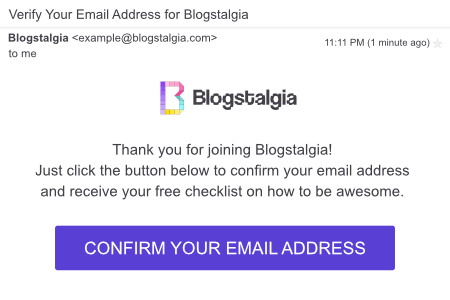
For years, this has been a debate among email marketers, but both of these types of opt-ins have their pros and cons.
Single Opt-In
The main benefit of a single opt-in is users are immediately added to your email list, so you’ll end up with more subscribers.
Unsurprisingly, email marketers using a single opt-in typically see a 20-30% faster list growth, according to GetResponse.
The downside is that you’ll end up with a lot of fake and mistyped email addresses, which can affect your open rate reports, deliverability, and cost you more money (most ESPs charge based on how many subscribers you have).
Double Opt-In
The reason some marketers decide to use double opt-in is to build a more engaging and quality email list.
With double opt-ins, fake and mistyped email addresses won’t be added to your list since they won’t be confirmed. This will lead to more accurate open rate reports.
Also, users that confirm their address are less likely to report your emails as spam. This is good news because too many spam complaints will lower your deliverability and eventually get you kicked out from your ESP.
The downside of double opt-ins is that only 80% of leads will go through the trouble of confirming their email address, according to Litmus.
My Preferred Opt-In
I like keeping my list clean and engaged, so I typically go for double opt-ins. You can try them both and see which one works best for your business.
c) Web Traffic
Another big struggle for businesses is driving traffic to their websites. Obviously, without traffic, there won’t be any subscribers.
There are many platforms you can use to drive traffic, but the best ones tend to be search engines like Google and Pinterest.
The issue with social media platforms like Facebook and Instagram is that they’re meant to keep users in their platforms, not drive traffic out of them.
They’ve also become pay-to-play, so if you want to get your products or services noticed on those platforms, you’ll have a better chance if you spend money on ads.
If you’re having trouble getting traffic to your site, I highly recommend you start learning the basics of Google SEO and then use another search engine like Pinterest as a second traffic source.
How to Choose an Email Marketing Software
The best email marketing software for you will depend on:
- How much customization and features you need
- How much you value deliverability
- How much time you want to spend learning how to navigate their interface
- Your budget.
I personally use ConvertKit, which you can get started with for free. The main reason I use them is because they have great deliverability.
To me, nothing really matters if my emails aren’t getting delivered
In this section of the guide, I’ll show you a few things to consider when choosing your email marketing software and a list of different options to choose from.
What to Look for in an Email Marketing Software
a) Deliverability
This is the main thing I look for in my email marketing software. As I mentioned above, nothing really matters if my emails aren’t getting delivered. You don’t want to go for an ESP that has several blacklisted IP addresses.
b) Features
Next thing I like to look for is the features they include.
Look for an ESP that has the features you need or think that will need in the future. There’s no need to jump into the one that offers the most features if you’re not going to use them.
The main feature I look for is their segmentations. Do they have a good and easy way to group people based on their different interests?
Other than that, here are some common email marketing software features you could look for:
- Automation – most ESP should have automations. This will let you set a sequence of emails to be sent automatically.
- Easy integrations – integrations will allow you to connect your ESP to things like your eCommerce store, lead captures, payment systems, course creation platforms, and more.
- Landing pages – I personally create my landing pages using my WordPress theme, but if you don’t know how to customize yours, you can look for an ESP that includes several professional-looking landing page templates.
- Opt-in form templates – same as landing pages, you can use your ESP’s pre-made opt-in form templates so you don’t have to spend time designing your own.
- Responsive layouts – nowadays, most people consume content on their phones, so make sure that your ESP has mobile-responsive layouts.
Again, depending on your needs, you might want to look for different features. But these are what most people look for in an email service provider.
c) Analytics
Having access to analytics will allow you to see how well (or how bad) your email campaigns are performing.
This will allow you to test different email marketing strategies and campaigns and make the changes needed to increase conversions.
This is actually a very important feature that some people take for granted. Gathering data and analyzing your strategies is extremely important.
You can’t improve something if you don’t know how it’s performing.
Your email service software should allow you to see things like click-through rate (CTR), open rate, and deliverability.
Others include even more advanced analytics like ROI.
d) A/B Testing
A/B testing in email marketing is the process of sending one variation of your campaign to a subset of your subscribers and a different variation to another subset. The goal here is to see which variation of the campaign yields the best results.
For example, you could test things like your subject lines, email copy, different templates, and the copy on your call-to-action buttons.
Some ESPs will automatically send the campaign with the best results to the rest of your list after the test has concluded.
Pretty cool, right?
e) Ease of Use
If you don’t have much experience with ESPs and don’t have time (or want to) figure out how to navigate a complicated dashboard, then using an ESP with an intuitive interface is probably a good idea.
Out of all the ESPs that I’ve tried, I’d like to say that ConvertKit and MailerLite have the most user-friendly dashboards.
ActiveCampaign has a lot more features than ConvertKit and MailerLite, which is great for those running big companies with very complex segmentations, but it isn’t very user-friendly. I also felt the dashboard was a little slow.
Most ESPs offer free trials or free plans up to a certain number of subscribers so you can try them out and see which one you like.
Don’t worry, we’ll go over the different email service providers in the following section.
f) Pricing
Pricing can vary a bit between ESPs. So it’s definitely something to consider if you have a tight budget.
As I mentioned earlier, there’s no need to pay more for a fancy ESP that has a ton of features that you’re not going to use.
For those with less than 1,000 subscribers, the pricing of an ESP can be between $10-30 per month depending on which one you choose.
g) Support and Documentation
Creating email sequences, setting up integrations, customizing emails, and setting up things like your SPF and DKIM can be a little frustrating for non-techies.
I always like looking for software and companies that have extensive and detailed documentation so I can find stuff and fix things myself without having to contact support.
I also like going with companies that offer 24/7 live chat support so I can quickly get in touch if there’s something I can’t fix on my own.
If you’re not a techie person, try looking for an ESP that offers great and knowledgeable support.
Just keep in mind that some companies won’t provide support if you’re using their free plans (they might offer email support, not live chat).
Email Marketing Software
Okay, now that you know what to look for in an email service provider, let’s take a look at some of the most commonly used ones.
1. ConvertKit
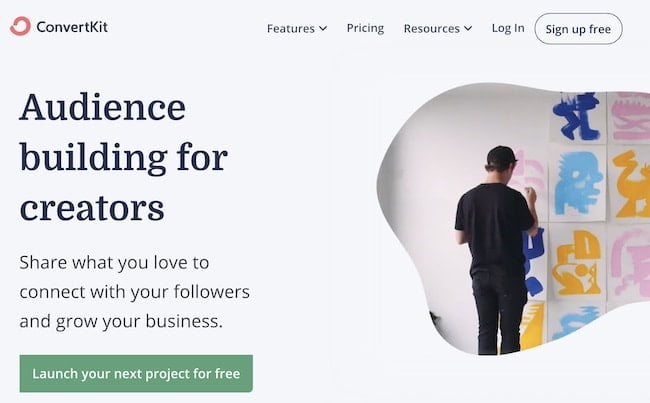
ConvertKit is the email service provider that I currently use for all my sites, mainly because they have good deliverability.
Besides that, they have visual automations, which makes it very easy to create complex “if this, then that” rules.
They have the most minimal and easy-to-use dashboard that I’ve seen.
They also offer several landing page and opt-in form templates as well as ways for you to sell digital products without having to pay extra for a different software like SendOwl.
With ConvertKit Commerce, you can set up one-time purchases for products like an eBook or recurring subscriptions.
You can use the free plan of ConvertKit for up to 1,000 subscribers. The only downside of the free version is that you can’t create automation, only send broadcasts. But you still get to use all their other features like landing pages, forms, ConvertKit Commerce, and support.
Pricing: Free up to 1,000 subscribers. Paid plans start at $30 per month for up to 1,000 subscribers.
2. MailerLite
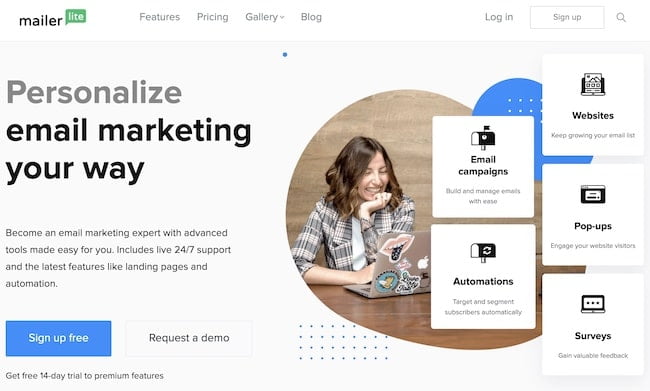
After ConvertKit, I feel like MailerLite has the most user-friendly dashboard. MailerLite is more for people looking for basic email needs at an affordable price.
They offer landing pages, pop-ups, and surveys. Their deliverability is okay, not the greatest, but not bad for the price.
You can use MailerLite for free for up to 1,000 subscribers. The good thing about the free version of MailerLite is that you can set automations, which you cannot do with the free version of ConvertKit.
If you’re using segments and selling digital products, I’d go for something like ConvertKit or ActiveCampaign instead.
Pricing: Free up to 1,000 subscribers, paid plans start at $10 per month.
3. ActiveCampaign
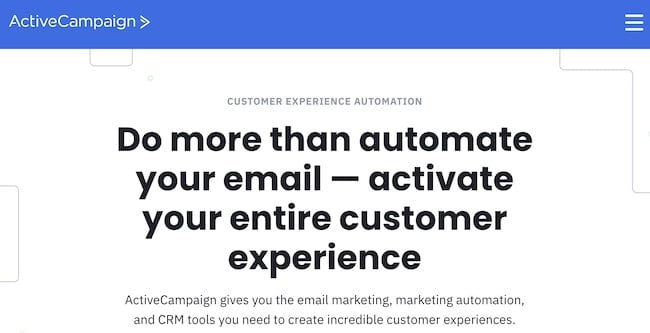
ActiveCampaign is best for those who require very advanced features. They give you so much control over the things you can do. It’s actually pretty cool.
Their platform isn’t as easy to use as ConvertKit or MailerLite, so it will require you to spend some time learning how to use it.
One thing I’ve noticed when using their platform is that it’s a little slow. Things take longer than they should to load.
Unfortunately, ActiveCampaign doesn’t have a free plan, only a free 14-day trial (no credit card required).
Pricing: Plans start at $15 per month for 500 subscribers.
4. AWeber
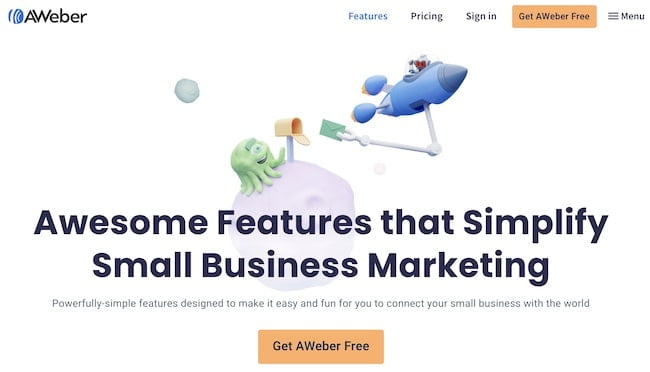
AWeber is a very popular email service provider that’s affordable. Their platform is very minimal and straightforward.
One thing that sets AWeber apart from other ESPs is that they offer the same features and capabilities with every plan instead of adding them for plans at different price points.
So their pricing is only based on the number of subscribers that you have, not on the features you need. Doesn’t matter if you have 10 subscribers or 30,000 subscribers, you’ll get the same features.
Pricing: They offer a free plan for up to 500 subscribers. Their cheapest paid plan is $19 per month for 500 subscribers. The next plan is $30 per month for 2,500 subscribers.
5. GetResponse
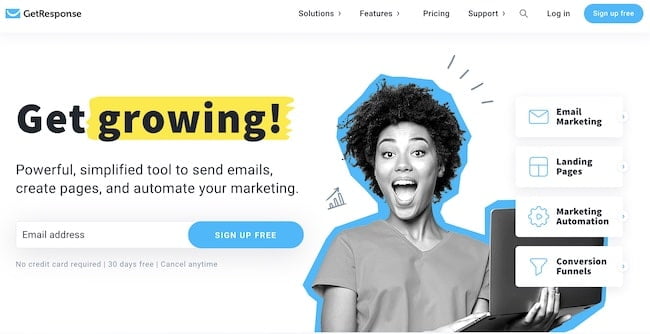
Besides allowing you to run email marketing campaigns, GetResponse has something they call Autofunnel, which allows you to create funnels for sales, webinars, leads, and more. This is fully automated.
Pricing: Free 30-day trial with no credit card required. Paid plans start at $15 per month for 1,000 subscribers.
6. Drip
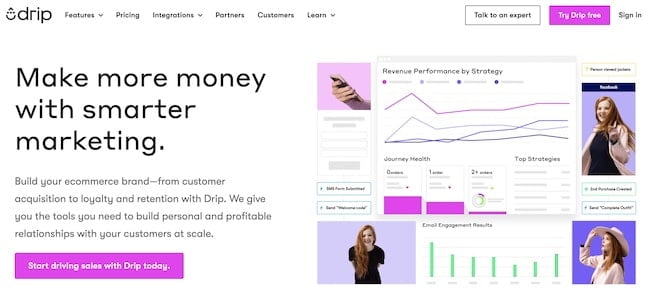
Drip is more than just an email marketing software. They’re more of an all-in-one solution that specializes in eCommerce.
If you’re selling tons of physical or digital products, then Drip might be a good option for you. They have very advanced data analysis tools that allow you to study things like customer intent and purchase behavior.
You can also target users who abandoned their carts, segment new site visitors from returning customers, and send SMS messages.
Their platform integrates easily with WordPress, WooCommerce, Facebook Ads, and other tools.
Pricing: They offer a 14-day free trial with no credit card required. Their cheapest paid plan is $19 per month for 500 subscribers. The next plan is $29 per month for 2,000 subscribers.
7. Sendinblue
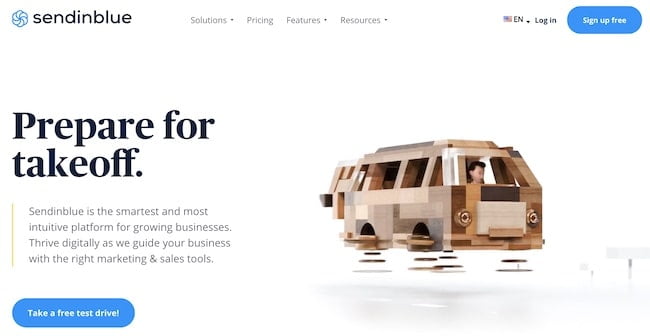
Sendinblue is most commonly known as a platform used to send transactional emails, but they also offer a fully automated email marketing solution for businesses.
They have more than 60+ responsive email templates, several email opt-in forms, and advanced reporting.
Their pricing plans are a bit different than other email service providers. Instead of charging you based on subscribers, they charge you based on the number of emails you send.
Pricing: Free to send up to 300 emails per day with no subscriber limit. Paid plans start at $25 per month for up to 100,000 emails per month with no daily limit.
8. Mailchimp
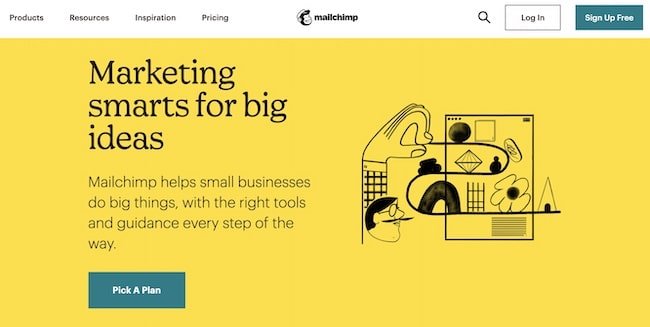
Mailchimp is arguably the most popular email service provider available. In fact, it was the first one I ever used.
The platform is great for beginners because it’s user-friendly and affordable. Plus, due to their popularity, plenty of tools integrate well with it.
Pricing: Free for up to 2,000 subscribers, but if you want to use autoresponders or other more advanced features, you’ll have to upgrade. Their paid plans start at $9 per month.
9. Constant Contact

Constant Contact is another popular email marketing software with okay deliverability. Just like Mailchimp, they have tons of integrations.
Pricing: They don’t have a free plan but they offer a 60-day free trial. Their paid plans start at $20 per month for 500 subscribers.
Segmenting Your Email List
Next thing we’ll cover in this email marketing guide for beginners is segmentation.
The reason many people believe email is dead is because they’re still using the old “email blast” technique.
This technique of sending the same emails to everyone is, in fact, dead.
Marketers who keep improving in their field and adapt to new trends are seeing a great ROI from segmenting email lists.
What is Email Segmentation?
Email segmentation is when you group people on your list based on specific criteria. Segmentation is used to deliver more relevant emails to subscribers based on things like purchase history, location, and interests to increase conversions.
Why Is Email Segmentation Important?
Let’s say you have a fitness business, and on your website, you post recipes and workouts.
Without a segmented list, you’ll end up sending the same emails to every subscriber regardless of what they’re actually interested in.
Chances are, some subscribers who are interested in workouts won’t be interested in recipes. Similarly, those interested in recipes might not be interested in workouts.
If you keep sending recipes to those who are only visiting your site to check out workouts, they might end up unsubscribing.
With a segmented list, you can send new recipes to those interested in recipes, and new workouts to those interested in exercise.
Segmenting your email list will lead to:
- Better open rates – not surprisingly, sending more relevant emails to your segments will increase your open rates.
- Higher ROI – your buyers aren’t all the same. Also, some will be at a different stage in the sales cycle. Sending targeted email will allow you to address specific issues they might be experiencing at the stage they’re currently at.
- Better customer retention – you won’t annoy customers with emails that are not relevant to them and make them unsubscribe from your list.
- Higher click-through rate – segmented lead nurturing emails generate an 8% click-through rate compared to general email sends, which generate only 10%, according to research done by HubSpot.
- Better deliverability – having lower spam reports and higher open and click-through rates will help your email sender reputation, which will increase your deliverability.
Email Segmentation Examples
How you segment your list will depend on the type of business you’re running and how big and broad your list is.
Here are a few of the most common ways you can segment you list:
- Preferences – you can have a segment of subscribers who want to read your blog posts and a different one for those who only want to receive notifications about their account or sales.
- Cold subscribers – you can send an email to inactive subscribers and ask them if they want to be kept or removed from the list. This is a good way to clean up your list and only keep engaged subscribers, which will lead to higher open and click-through rates.
- Interests – subscribers who want keto recipes vs. vegan recipes.
- Open rate – you can send special deals to those subscribers who actually open your emails and engage with your content.
- Shopping cart abandonment – send a reminder to subscribers who put items on their cart but haven’t checked out yet.
- Buying behavior – subscribers who only buy during special occasions like Christmas vs those who purchase frequently.
- Location – send notification to subscribers about events near their area.
Again, there are plenty of other ways you can segment your email list.
How to Improve Email Deliverability
Next thing we’ll look at in this email marketing guide for beginners is improving email deliverability.
Unfortunately, getting your emails to land on someone’s inbox instead of their spam box isn’t as easy as it used to be several years ago.
Spammers and scammers taking advantage of the effectiveness of email marketing have lead email services like Gmail and Outlook to toughen up their spam filters.
This has made it difficult for legit businesses to reach their customers.
Here are a few things you can do to increase your chances of landing on people’s inbox instead of spam:
- Maintain good IP reputation – your sender’s IP address’ reputation is one of the biggest factors affecting deliverability. If you’re sending emails from an IP with poor reputation, you’ll most likely end up in spam. That’s why it’s important that you choose a good email service provider that doesn’t have blacklisted IPs.
- Authenticate your email domain – make sure that you enable sender policy framework (SPF) and domain keys identified mail (DKIM). This will define which IP addresses can be used to send emails from your domain, which will help prevent scammers from sending emails on your behalf—email spoofing.
- Use a familiar sender name – make sure that your subscribers know who’s emailing them by using your actual name or your brand’s name. Also, try sending from email addresses that include a name like tommy@rugrats.com instead of team@rugrats.com.
- Add an unsubscribe link and physical mailing address in your footer – the law requires commercial emails to include an unsubscribe link and a physical mailing address.
- Ask subscribers to whitelist your emails – let subscribers know how to whitelist your emails so that you’re not stopped by their spam filters.
- Keep your email list clean – internet service providers (ISPs) base complaint rates on active subscribers, not total subscribers. So even if you acquired legit subscribers, you’re at risk of being labeled as a spammer if you don’t clean up your list.
- Keep your email template code clean – try to avoid adding poorly-coded HTML on your emails.
- Use double opt-in – as covered earlier, using double opt-in will help keep your list clean by preventing fake or mistyped emails to be added to your list.
- Don’t buy email lists – absolutely not. Never add to your email list people who haven’t voluntarily opted in.
- Don’t use video or JavaScript inside your email – most email providers don’t support things like Flash or video embeds. Instead, use an image with a play button that links to the video on a web page. Most email clients won’t allow JavaScript or other dynamic scripts to function, so no need to use them.
- Don’t use large images or too many images – using too many images can make your email land in the spam folder. So only use one or two images. Also, make sure that you reduce the file size by resizing and compressing them.
- Avoid spam trigger words – some words like buy now, Viagra, bonus, sale, and weight losscan trigger spam filters.
- Consider a dedicated IP – once you’re sending around 25,000 emails per day, you might want invest on a dedicated IP address.
How to Test Your Email Deliverability
If your email service provider doesn’t allow you to check your deliverability rate, you can use other free tools like Mail-Tester, MX Toolbox, and Spamcheck.
How to Increase Email Open Rate
The next challenge after successfully making it into someone’s inbox is to get them to actually open your emails.
The average email open rate between 2015 to 2018 was 24%, however, in 2020 it dropped to 21.3%.
Here are a few easy ways to increase your email open rate.
1. Remove Inactive Subscribers
Needless to say, subscribers that have a history of not engaging with your emails—cold subscribers—will drive your open rate down.
If someone hasn’t opened any of your emails in more than 6 months, you can consider them as inactive.
Now, before you start kicking people out of your list, send them a re-engagement email to make sure they don’t want to be part of it.
You could use an engaging subject line like, “Do you want to break up?”, “Am I boring?”, or “I guess it’s goodbye.”
And then tell them to reply or click a link if they want to stay on your list.
2. Segment Your Email List
Dividing your list into smaller groups based on interests—segmentation—will help you send more relevant emails to your subscribers, which will boost your open rates.
In fact, segmented lists see can see an average of 39% higher open rates than non-segmented lists, according to research done by Lyris.
3. Send Emails at the Right Time
The timing of your emails can have a great impact on your open rate.
If you’re just starting to build an email list, you probably don’t have enough data to see what are the best days and times to send your emails out. So you’ll have to run some A/B tests to find out.
Now, some big companies like GetResponse and Mailchimp have already done some studies that you can use as a baseline
During their research, GetResponse found that emails sent on Tuesdays have the highest open and click-through rates.
Data gathered by Mailchimp found that it’s best to send emails on weekdays instead of weekends, and the optimal time of day to send emails is at 10 AM in your recipients’ own time zone.
Again, this will depend on your niche and audience, so test things out.
4. Create Curiosity with Your Subject Line
A great way to ensure that people open your emails is to create curiosity with your subject lines.
Obviously, don’t be so mysterious that your subscribers have no idea what you’re talking about. Also, be sure to deliver what you promised, don’t craft clickbait subject lines that have nothing to do with the content inside the email.
5. Personalize Your Emails
Most people think that personalization is just adding people’s names in subject lines and the body of the email, but it is more than that.
Personalization is about using data you have about your subscribers to tailor individual experiences and respond directly to their ever-changing needs in real-time.
The difference between segmentation and personalization is that segmentation targets a group of people with common characteristics while personalization focuses on an individual user.
True personalization should:
- Make content individual for every single user
- Be updated in real-time based on personal characteristics
- Be frequently updated based on user interactions and likings
6. Write Like a Friend
People are tired of receiving generic messages from big companies that don’t really care about them and only want their money.
When writing emails, just be yourself and imagine you’re sending a message to a friend.
Instead of writing something like, “We’re giving 20% discount to all our customers,” you could write something like, “You’ve gotta check out this deal.”
7. Only Send High Quality Content
Don’t send emails just for the sake of sending emails. That’s the quickest way to get people to unsubscribe from your list.
A good way to ensure that your subscribers love opening your emails is that you only send them high-quality content.
Don’t send them info that could be easily found on Google. Instead, send them valuable information that helps them with whatever issue their having.
Also, stay up-to-date with things going on in your industry. Send them emails that will make them go, “Whoa, I didn’t know this!”
8. Set Expectations With Subscribers
Another way to improve open rates is to let your subscribers know how frequently you’ll be emailing them.
Is it every Wednesday? every Tuesday? is it three times a week?
Automated Email Marketing Campaigns
One of the biggest advantages of email marketing is that you can automate the whole process and make money even while you’re sleeping like a baby.
What Is Email Automation?
Email automation is the process of sending emails automatically from your email service provider to your subscribers after they’ve completed an action on your website, such as joining your list, buying a product, or abandoning their cart.
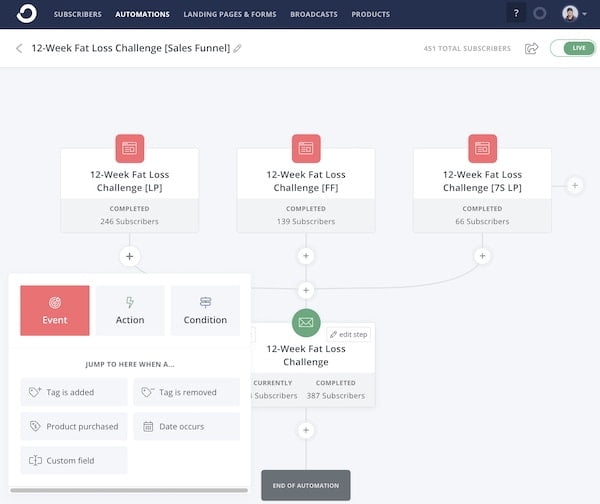
What Is Email Automation Used For?
You can use email automations for several different things, but here are some of the most common ones:
- Sending a welcome sequence – a welcome sequence is a series of emails sent to your new subscribers. You can use this to deliver the lead magnet you promised, thanking them for subscribing, introduce yourself and your brand, point them to your most popular blog posts, and more.
- Using it as a lead magnet – it’s very common for marketers to use email automation as lead magnets. For example, you could offer a free mini-course or challenge and use automations to deliver a new lesson each day or week (depending on how you set up your course or challenge). These types of lead magnets are very effective. In fact, I use a challenge on my fitness site and a mini-course on this one.
- Creating sales funnels – An email sales funnel is a series of emails sent to your leads to convert them into customers. For example, you could create a funnel that goes like this: provide value to subscribers, introduce your product and show them how it can help, show them results from others who have used it, and the finish off by introducing a limited time deal.
- Promoting upsells – once someone has purchased one of your products, you can send them another email sequence for other products they might be interested in. For example, if someone bought an iPhone, you could send them offers to other products like phone cases or screen protectors.
How to Create an Email Automation
The first step for creating an email automation is to identify what kind of automation you want to create.
As mentioned above, this could be a welcome sequence, a sales funnel to one of your products (or an affiliate’s), or a mini-course.
Next, you want to decide how many emails you want to include and how long you want the sequence to last. For example, you could have a 7-day sequence with 8 emails or a 5-day sequence with 5 emails.
This is what a typical email sales funnel looks like:
- Email 1 – deliver your lead magnet and provide value to your subscribers
- Email 2 – provide more value
- Email 3 – touch on their pain points. Show them that you understand what they’re going through
- Email 4 – introduce your product and show them how it can help them. You can also introduce a limited-time discount or bonus
- Email 5 – include a list of your frequently asked questions
- Email 6 – remind them that today’s the last day to get the special offer
- Email 7 – last call. This should be sent on the same day as the previous email but just a few hours before the deal expires
This example is a 6-day funnel with 7 emails. Remember, you always want to provide value first. Otherwise, people are going to think you don’t care about them and just want to sell them stuff.
Email Regulations
Next thing we’ll cover in this email marketing guide for beginners is email regulations.
As mentioned earlier, you can’t simply start emailing random people anything you want.
There are several laws and guidelines you must adhere to when sending commercial emails.
For example, you’ve got the CAN-SPAM Act in the US, the CASL laws in Canada, and the Privacy and Electronic Communications Regulations of 2003 in the UK.
Here are some of the rules you must follow to comply with all the laws across the globe:
- Permission to email – you can’t add people to your email list who haven’t opted in. People need to give you permission before you can send them marketing campaigns. This permission often comes from visitors entering their email address in a subscribe form on your site.
- Visible way to unsubscribe – all marketing emails should include a visible unsubscribe link or button. You cannot make it difficult for someone to find it.
- Physical mailing address – you must also include a physical mailing address. If your business doesn’t have a physical office, you’ll have to put your home address or rent a P.O. Box, which can cost around $100 per year depending on where you live. Those using ConvertKit are allowed to use ConvertKit’s address instead. They will open and send you images of important mail that you receive. This is something that other ESPs don’t do.
- Use real email addresses – always include real email addresses in the “From” and “Reply to” fields.
- Honor opt-out requests quickly – the CAN-SPAM laws stipulate that you must honor someone’s opt-out request within 10 business days and you can’t charge a fee, ask for any extra information, or make them take other complicated steps besides sending a reply email or visiting a page on your site to opt-out.
Note: This is not to be confused for legal advice. If you want more specific legal information regarding CAN-SPAM Laws, visit FTC’s site.
Measuring Email Campaigns Performance
One thing that other email marketing guides tend to ignore is teaching you how to analyze your email campaign data.
Once you’ve created and sent your first campaign, you’ll be able to start tracking how well your email marketing efforts are performing.

Here are a few of the most common metrics you’ll see in your campaign data:
- Number of unique opens – the number of unique subscribers who opened your campaign.
- Number of bounces – the number of email addresses to which your campaign could not be delivered.
- Number of unopened emails – the number of unique subscribers who didn’t open your campaign.
- Open rate – the percentage of subscribers who opened your campaign.
- Click-through rate – the percentage of subscribers who opened your campaign and clicked a link inside the email.
- Unsubscribe rate – the percentage of users who unsubscribed from your email list through a specific campaign.
- Spam complaints – the percentage of people who marked your campaign as spam.
- Shares – the number of people who forwarded your campaign using the forward icon inside your email or shared it through social media.
Keep in mind that the names of these metrics might change slightly depending on your email service provider.
Open Rate and Click-Throughs
These are the two metrics you’ll probably use the most, as they can tell you how well your subject lines and campaign content resonates with a particular list.
The average email open rate is about 21%, according to data analyzed by Mailchimp, however, this can vary based on your industry.
For example, government-related emails tend to have the highest open rate at 28.77% followed by hobbies at 27.74%.
Vitamins and supplements tend to have the lowest at around 15.03%.

Once you know where you stand in comparison to others in your industry, you can start running some A/B tests to improve your open and click-through rates.
How to Calculate Email Marketing ROI
Return on investment (ROI) measures the gain or loss generated by an investment in relation to its initial cost. In this case, it will allow you to see how well your email marketing efforts are performing.
Email Marketing ROI Formula
ROI can be calculated using the following formula:
ROI = [(Amount Gained – Amount Spent)/Amount Spent]x100
Where Amount Gained is the amount of income generated by an investment and Amount Spent is the total amount spent on an investment.
How to Calculate Your Spend
The first step in calculating your email marketing ROI is to find out how much money you’re spending on it.
If you’re riding solo, then your email service provider will most likely be your only expense.
However, if you have a team of marketers working for you, you’ll have to calculate how much time each member of the team spends directly on email marketing and convert it into an hourly rate.
How to Calculate Your Gain
If you’re selling products online and your ESP has Google Analytics integration, you can easily track sales that come from an email.
One way to do it is to calculate the value of a lead.
With Google Analytics, you can trace every conversion that can be attributed to your email campaign, including web traffic.
Then, you can multiply the number of conversions by the value of a lead to get the total revenue generated by your email campaign.
How to Calculate Your Email Marketing ROI
Once you’ve got your spent and gain values, you can plug them into the ROI formula.
ROI = [(Amount Gained – Amount Spent)/Amount Spent]x100
Let’s say you pay $100 per month for your ESP, which comes out to $1,200 per year. You also have an employee working on your email marketing campaigns for 3 hours, 5 days a week at a rate of $15/hour, which comes out to $11,700.
In a year, you would spend a total of $12,900 ($1,200 + $11,700) in email marketing.
If the value of your lead is $100, and your email campaign brings 400 leads per year, your total gain is $40,000.
Now that you have your gain and spent value, you can go ahead and calculate your ROI.
ROI = [($40,000 – $12,900)/$12,900]x100
This will yield an ROI of 210%.
Common Email Marketing Mistakes
In this last section of the email marketing guide for beginners, we’ll go over some of the most common mistakes to avoid.
1. Asking for the Sale Right Away
Asking someone to purchase your product on the first email is like asking someone to marry you without getting to know them first. (I know this is common in some cultures, but you get my point.)
To increase conversions, about 80% of the emails you send should provide value, and only 20% of them should be trying to make a sale.
That’s why nurturing sequences are so important and effective when it comes to email marketing.
2. Not Optimizing for Mobile
Optimizing your website and emails for mobile is not optional anymore. It’s just something you must do if you want to rank high on Google and keep your subscribers happy.
Nowadays, most people consume content on their phones.
There’s a reason why Google now uses the mobile version of your website for indexing and ranking—mobile-first indexing—instead of the desktop version.
Nowadays, most people consume content on their phones, so you must make sure that your emails display correctly on mobile.
That means no overflowing text or unresponsive images.
3. Not Including a Clear Call to Action
When sending emails, you have to clearly tell people what you want them to do.
Whether it is clicking a link to read a blog post on your site, purchasing a product, or registering for a webinar.
Now, you do not want to add several call-to-actions and confuse your readers. Your emails should have one or two clear call-to-actions.
4. Failing to Track Your Email Campaigns
One of the biggest mistakes small businesses make is not tracking their email campaigns.
Without measuring the performance of your email marketing campaigns, you won’t know how to improve them.
If you need a refresher, you can go to the section on measuring email campaigns of this guide.
5. Not Double-Checking Your Links
Don’t be one of those people who get so excited about how cool their email is looking that they forget to include the links or attachments.
Also, be careful if you tend to copy and paste links, as you might end up pasting the wrong link.
I can tell you from experience.
6. Not Checking Your Personalization
Another common mistake is not checking how your email looks before sending it.
If you’re using personalization tags to include things like your subscriber’s first name, you want to make sure that you’re typing them correctly.
The last thing you want is to send an email that said “Hi {{ subscriber.first_name | strip | default: “there” }}.”
This is one of the reasons why I don’t like using personalization tags in my subject lines.
7. Sending an Email to the Wrong List
If you’re running several emails lists and segments, you have to make sure that your emails always go to the right set of subscribers.
Sending emails to the wrong list can lead to tons of unsubscribes, spam complaints, and angry customers.
8. Having the Incorrect Scheduling Settings
Make sure that you have the right scheduling settings when automating your email campaigns.
The last thing you want is to end up sending three emails back-to-back when they were supposed to be sent one day after the other.
Just like sending an email to the wrong list, this can annoy your subscribers and make them hit that unsubscribe button.
If you’re sending emails based on your recipients’ time zones, make sure you double-check that as well.
9. Not Segmenting Your List
As I mentioned earlier, segmenting your email list is extremely important if you want to maximize your earnings, open rates, and click-through rates.
This will allow you to send more relevant emails to your subscribers and lower your unsubscribes.
If you skipped the section on segmentation, you can click here to check it out.
10. Sending Several Emails on the Same Day
Depending on the type of business you’re running, you might have the same people subscribed to more than one of your lists.
If this is the case, you want to make sure that you don’t email all of your lists on the same day.
For example, let’s say you have a weight loss, recipes, and workouts list, and a person who subscribed to all of them.
If you normally email all of your lists on Wednesdays at 10 AM, that person will receive three emails at once, which can be a little annoying.
Some people might even forget they signed up for so many of your lists and wonder why the heck you’re emailing them so much in one day.
A good way to prevent this is to set a different day for each list. For example, you could email your weight loss list on Mondays, send some recipes on Wednesdays, and then workouts on Friday.
Final Thoughts: Email Marketing Guide
As you can see, email marketing is more than alive today. However, in order to run a successful email campaign, you can’t be using old “email blasts.”
Instead, you need to adapt to the new trends and use things like segmentation and personalization to really connect with your subscribers and turn them into recurring customers.
I hope this email marketing guide for beginners was extremely useful to you. If you have any questions, feel free to leave them down below.

